Austin Gas Turbine Car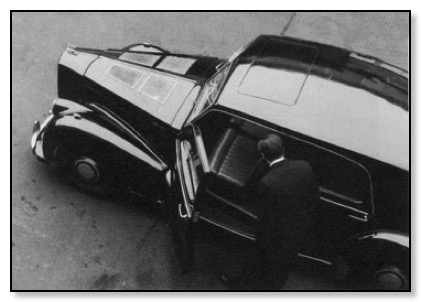
Modified Austin Princess Gas Turbine
Work on a gas turbine engine was started in April 1952 in the East Research Longbridge. Dr John Weaving led the team to look if it was feasible to produce an engine that could be fitted into a car. At this time Rover had demonstrated in March 1950 with Jet 1. These engines had an output of 230bhp at 26,000 rpm which was fitted to the rear of a standard P4 chassis.
Austin did not wish to be seen as not keeping up with modern thinking. It was important to show the public that Austin did have the technical expertise.
It was in early 1949 when work started in East Works Research & Development Department under Doctor John Weaving. The project was given the name Fluid Flywheel. The department was housed in the old aero-engine test house which during the war tested the Longbridge built Bristol Mercury and Pegasus engines.
One of the main components of a jet engine is the compressor, so to build the first engines a compressor from a Spitfire Merlin engine was used. From this design various changes were made and they produced their own version, which would be more suitable for a car. To ignite the turbine in the early tests an oily rag was lit on the end of a long pole.
In August 1954 after bench testing, and curing one of the main problems, which was with the turbine blades that had to cope with the centrifugal forces whilst spinning at 23,000 rpm, the engines optimum speed, produced a power output of 125 hp.
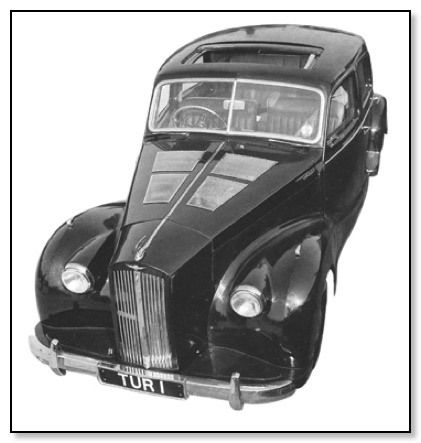
The engine was installed in a modified Austin Princess, as you can see from the pictures, it was necessary to length the bonnet, mainly to accommodate the air intake silencers at the front, which reduced the familiar jet whistle. It was this noise when driven on the public roads that often made heads look upwards expecting a jet aircraft to go over. But inside the car the noise level was regarded as acceptable. The grills on the bonnet are to let the heat from the engine to escape, no problems with de-misting on this vehicle.
Testing was carried out at Honeybourne airfield where measurements could be taken. One of its main drawbacks was fuel consumption worked out at around four and a half miles to the gallon. It was designed to run on diesel as opposed to paraffin because diesel was road-legal and available at filling stations.
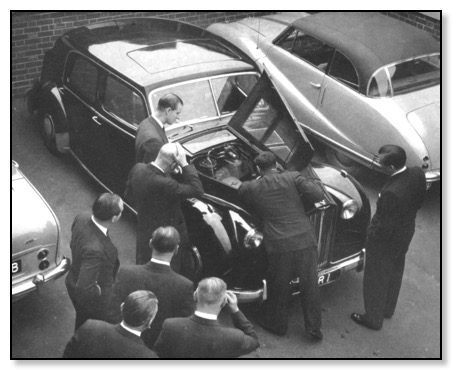
Duke of Edinburgh Inspecting TUR 1 (Dec 1955)
So how does it all work, air is drawn through the front grill and compressed, then the compressed air is passed to the heat exchanger where it is heated by the hot exhaust. This acts to reduce the amount of fuel needed to be burnt to reach the required entry temperature to the turbine. The hot gases then pass through the power turbine and rotate the shaft that is coupled to a Hobbs gearbox and onto the rear axle. The exhaust gas then pass through a heat exchanger before been discharged to the atmosphere.
The Hobbs gearbox was an early type of automatic so when the input shaft was turning at 600 RPM it would slowly move forward. TUR 1 was duly registered and ready for road test in August 1954. A few anxious moments the first time out as you had to nurse the car along, as it was slow to respond to the throttle pedal. It was capable of about 70 mph but used to only do about, on average 4.5 miles to the gallon. One of the hazards of driving this car was that if there was a slight leak of fuel or oil, because of the high temperatures you could soon have a fire on your hands.
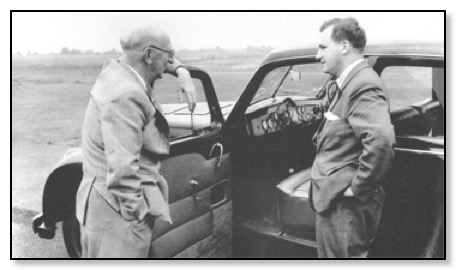
Leonard Lord with Dr John Weaving
Austin needed to show the Press and Public that it was at the forefront of developing cars of the future. So it was decided to show how progress was developing at the Austin Golden Jubilee (1905-1955) on Saturday July 9th 1955. In the cavalcade the modified Austin Princess purred past, sadly this was a publicity stunt. At low road speeds it had very little power so much so that it was towed up the steep ramp from east works onto the main road.
At the Golden Jubilee Event
Just a couple of years later Dr Weaving had to recognise that gas turbines were fine for aircraft but were impractical for cars, and actually in the 1970s were tried again in a Leyland lorry but this too was soon abandoned. The main problems was the amount of heat generated which has to be dealt with. Noise is a big problem, to get it down to an acceptable level for the passengers and the general public. It consumed fuel (diesel) at an alarming rate, not very eco friendly. The Princess was used as it was the only vehicle that could accommodate an engine of this size.
_________________
Memories of a schoolboy.
It would have been 1954 or 1955, at the time I was a schoolboy with a part-time job at Church Hill Farm in Beoley. The farmer, Gerry Hill, also had another farm at Storrage Lane on the way to Rowney Green. On the day in question Gerry instructed myself & some other lads, all younger than me, to walk the sheep to the Storrage Lane farm. There were about four or five of us lads in total, ample to control the sheep at junctions & prevent them from deviating into driveways, under normal circumstances. Unfortunately our journey that day was to be far from normal.
All went well until we reached the crossroads at the bottom of Beoley Hill. We became aware of a loud whining sound, apparently coming from an Austin Champ approaching from the South along the Icknield Street. The Champ was closely followed by an Austin Princess. As the vehicles got closer to us the noise became so loud that it was impossible to talk or in fact do anything other than look for the source of this incredible whine. All thoughts of the sheep were forgotten.
I remember wondering why the driver of the Champ didn't seem at all perturbed at the noise emanating from his vehicle, which surely any normal driver would have investigated forthwith. I was also very puzzled as to what on earth was making the whine, which was unlike any vehicle noise I had ever experienced before (or since!) I was already very familiar with the workings of motor vehicles, as I regularly assisted my father who did all of his own maintenance.
The source of the whine immediately became apparent when the Champ turned left into Dagnell End Road. We now realised the noise was nothing to do with the Champ as it was coming from the Princess! At the same time I observed the number plate TUR 1, which I knew about from the press reports, & of course the extended bonnet. Immediately I shouted out to the other lads that it was the Austin jet car, but of course my words were drowned out by the whine. As the Princess accelerated away towards the West the noise increased markedly, now added to by the whooshing sound from the four very large exhausts under the rear of the vehicle.
Once the Austin & it's accompanying Champ, (presumably an escort vehicle to tow the Sheerline if needed), had disappeared from view & the noise had stopped, we returned to our task with the sheep. Needless to say, they had been terrified by the noise & hadn't hung around to find out what it was. We rounded up all we could find, not being sure of the exact numbers anyway & continued on our way.
Meanwhile, Gerry Hill set out in his van to collect us lads & bring us back to Church Hill. Of course, with the delay we hadn't even reached the other farm yet when he caught up with us. More trouble, our explanations of being delayed by a jet car didn't go down at all well & it took us quite a while to convince him we weren't telling porkies.
Michael B. Davis.
Next Chapter for the Gas Turbine Team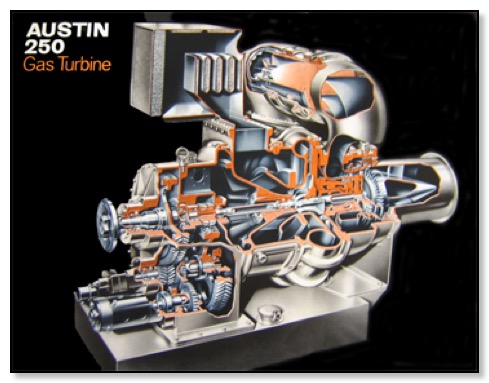
Gas Turbine Stationary Engine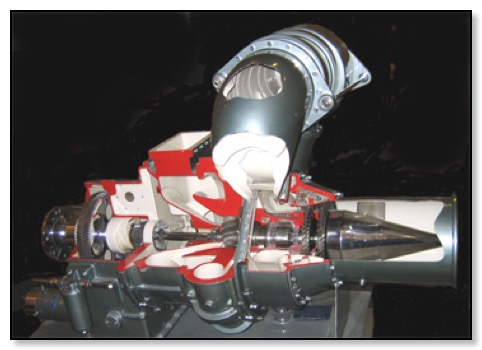
As a great deal of knowledge on gas turbines had been obtained under Dr Weaver leadership, development was then turned to see if there was a commercial use for the engine with modifications as a stand alone unit. So the new engine which had a single-shaft axial flow produced 250 bhp at 29,000 rpm. Its specific fuel consumption was 1.05 pints per bhp. It was decided that if coupled to a generator it could be used to supply power for emergencies say in a Hospital if power from the grid fails. Another use was to power a water pump which again would be used in an emergency. In fact in this case by having them on a trailer they could be taken where ever they were needed. A demonstration to publicise the uses that this engine could be used for was staged at the back of East Works. The engine/gearbox attached to the inbuilt fuel tank as shown above was priced in 1961 at £2,500 which in its day was cheaper than a diesel engine producing 250 hp by about £500. It was a very expensive engine to produce and although a fair number were sold, in the end each engine produced was loosing money, so the project was stopped.
Specification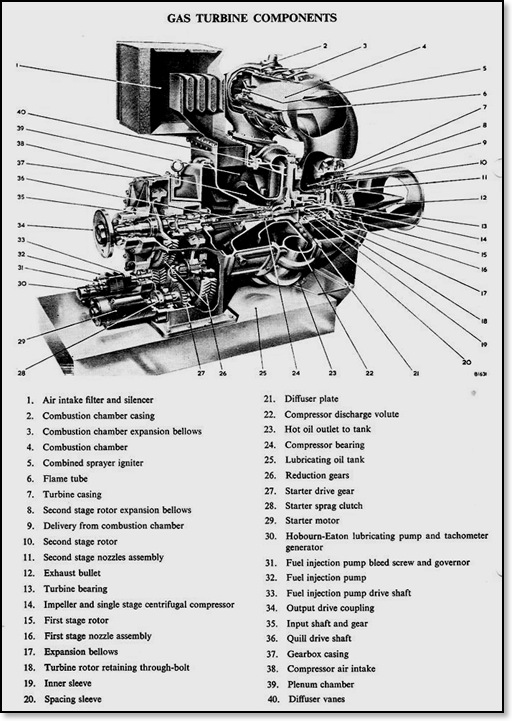
Engine only, including combustion chamber, ducting, exhaust ducts, gear-box auxiliaries, and controls 900 lb. Standard oil tank (lighter tanks are available for special applications) 3001b. Total engine weight 1,200lb. pump (Sigmund) and coupling (100 lb.) 1,250 lb. Bed for engine and pump 420 lb. Complete pumping set on bed with priming system, oil cooler, inlet and exhaust silencers, fuel tanks, suction spacer, and delivery manifold 3,700 lb. Service items (batteries, 50 gallons fuel, 20 gallons oil) 750lb. Alternator (Crompton Parkinson) and coupling 3,350 lb. Bed for engine and alternator 550 lb. Complete alternator set on bed with oil cooler. inlet and exhaust silencers, fuel tank 5,60O lb. Service items (as for pumping set) 750 lb. If coupled to a electric generator, power was transmitted through a gearbox that reduced the RPM down to just 1,500. Heat and noise was now no longer a problem even if the internal temperature would be around 800 deg C.
Engine only, including combustion chamber, ducting, exhaust ducts, gear-box auxiliaries, and controls 900 lb. Standard oil tank (lighter tanks are available for special applications) 3001b. Total engine weight 1,200lb. pump (Sigmund) and coupling (100 lb.) 1,250 lb. Bed for engine and pump 420 lb. Complete pumping set on bed with priming system, oil cooler, inlet and exhaust silencers, fuel tanks, suction spacer, and delivery manifold 3,700 lb. Service items (batteries, 50 gallons fuel, 20 gallons oil) 750lb. Alternator (Crompton Parkinson) and coupling 3,350 lb. Bed for engine and alternator 550 lb. Complete alternator set on bed with oil cooler. inlet and exhaust silencers, fuel tank 5,60O lb. Service items (as for pumping set) 750 lb. If coupled to a electric generator, power was transmitted through a gearbox that reduced the RPM down to just 1,500. Heat and noise was now no longer a problem even if the internal temperature would be around 800 deg C.
The Team behind the Project
(from car to stationary engine)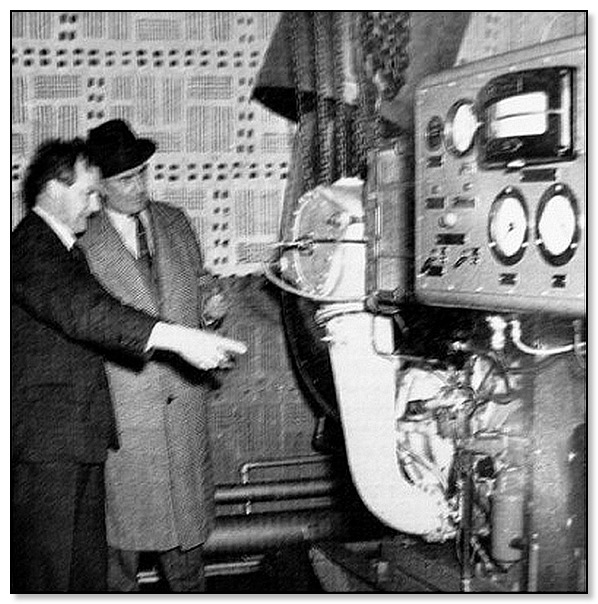
Dr Weaving showing the Gas Turbine on the test rig.
The Test Cells had been used in the war to test Aero Engines
The opening of the Electrical Engineers’ Exhibition at Earls Court on the 21st March 1961 was a particularly important day for a small group at Longbridge, for it was then that years of hard work in the Research and Development in East Works was to reveal to the World with the announcement of the 250 Austin Gas turbine Engine.
This announcement was the culmination of 12 years of team effort. during that time many people have been working on the project.
It first of all started in 1949 with a total of six employees who worked on making a gar turbine to be installed in a car.
The team of scientist and engineers were under the direction of Austin Chief Gas Turbine Engineer, Dr John Harold Weaving, As an Austin ex-apprentice he had obtain a London University B.Sc. degree, and then moved on to Cambridge University to do research on the internal-combustion engine. On returning to Longbridge in 1946 to be a superintendent in East Research. Not long after he was joined by Mr J Barton M.Sc.Tech.
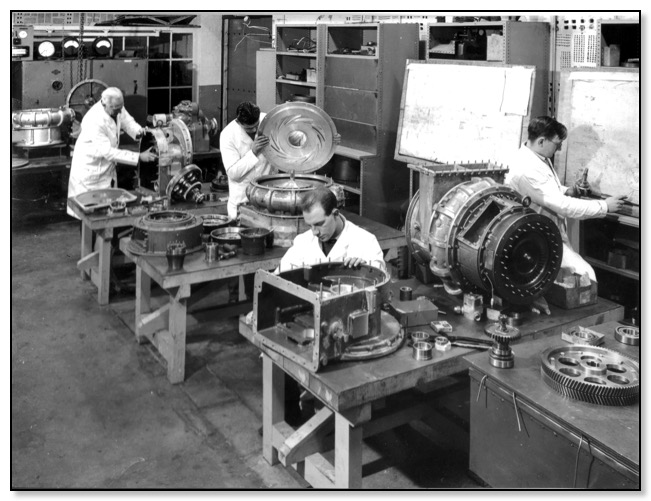
Gas Turbine Assembly Shop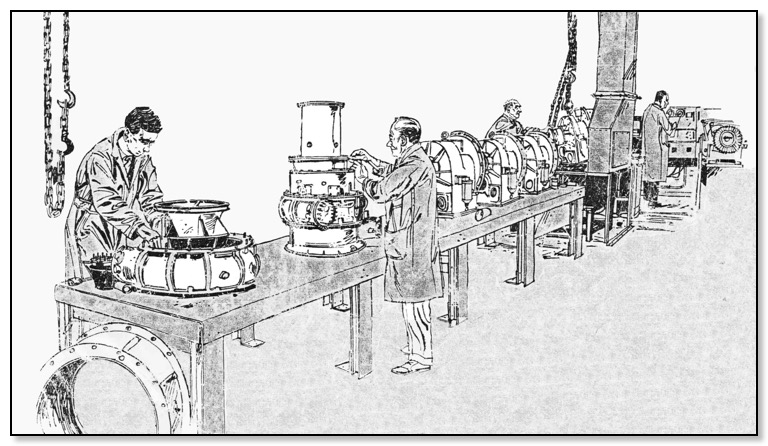
Showing the sequence of Assembly
Mr Bradley, who was in charge of engine testing, test housings, and equipment. He began an engineering apprentice with the Company in 1942 and later spent three and a half years at the National Gas Turbine Establishment before starting gas turbine work at Longbridge in 1949. He drove the gas turbine powered Austin Princess at the Austin golden Jubilee in 1955 and demonstrated that vehicle to the Duke of Edinburgh.
Other members of the team had also done an apprenticeship with other companies in the BMC group. and gained various university degrees.
One of the critical components of the engine is the compressor, this was the responsibility of Dr Tonks who had started his apprenticeship with the Nuffield Group.
In the early days there were just two fitters along with the foreman Mr Charlie Hawkins who had worked in the South Experimental Department for the last 12 years. the other two Mr Bradon Roberts and Mr Peter McNally were still apprentices.
In the early days work on the engineering drawings was done by three to four draughtsmen on an ad-hoc bases. But in 1957 a small design office was set up in East Research with six draughtsmen led by Senior Design Engineer, Mr D Rickman who had experience of working on gas turbines since 1949.
To machine the parts needed for the project, just one person did it all Mr J Smith who continued on his own for three years. As the project slowly moved from the development stage to production stage, and getting ready to start making them for sale. It was time to build the machine shop up, so a Mr Ned Harrison was brought in to be Machine Shop foreman and the workforce slowly increased to fourteen.
At the time of the announcement the total team had risen to 45 people.
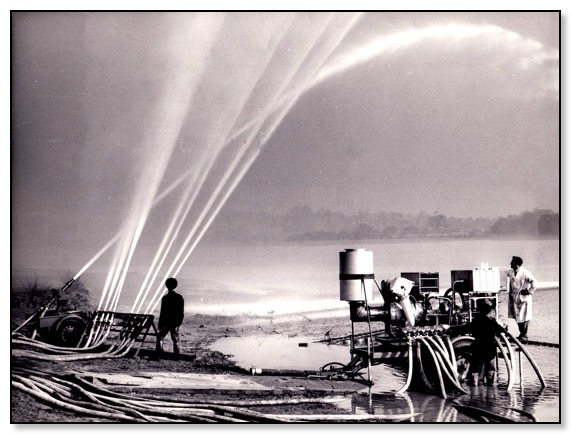
Demonstration of the engine driving a Water Pump
The pump is capable of delivering 2,500 gal/min at a pressure of 100 lbs/sq which as shown here can supply 8 hoses at full power. Although now fitted with an Exhaust Silencer, it was still very noisy.
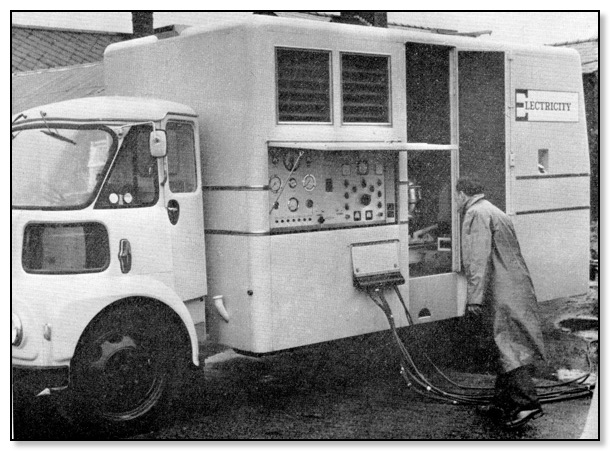
Mobile Power Generator
Gas Turbine driving a Power Generator
This unit can generate 200kVA
First showing in the U.S.A. of the Austin 250 b.h.p. industrial gas turbine is discussed by (left to right) Mr. D. G. Cardy Fleet Sales Manager of B.M.C. Canada, Mr. B. Stockdale, Assistant Technical Sales Manager of Austin Motor Export Corporation, Dr. J. Weaving, Chief Gas Turbine Engineer, Mr. G. Askwith, Vice-President of Mechron Engineering in Ottawa and Mr. R. Learoyd, Senior Executive of B.M.C. (U.S.A.) Ltd. The exhibit was at a Gas Turbine Products Show recently held in Houston, Texas
Working principle of the AUSTIN 250 Gas Turbine
The unit runs on gas oil or DERV, but is also suitable for conversion to operate on other distillate or gaseous types of fuel.
Air is drawn into a centrifugal compressor where it is compressed at a ratio of 3.5 : I and flows into the single combustion chamber. Here the compressed air is heated and greatly increased in volume by the introduction and burning of finely atomized fuel-a process which takes place with minimum loss of pressure. The resultant high-temperature gases are then directed from the combustion chamber, rapidly expanding through the two-stage turbine to the atmospheric pressure at the exhaust exit. Being directly coupled on the single shaft rotor, the turbine drives the compressor, thereby completing the simple open cycle.
Power is taken from the turbine rotor through a reduction gearbox to the final drive shaft and the driven machine.
Cooling air is directed from the compressor to the turbine discs and blades, keeping them at a much lower temperature than that of the hot exhaust gases passing over them, so avoiding damage from excessive thermal stresses. All the gears in the gearbox are machined to extremely close limits and are finely finished by grinding to ensure smooth, vibration-free running. The reduction gears have double helically cut teeth to eliminate end-thrust.

